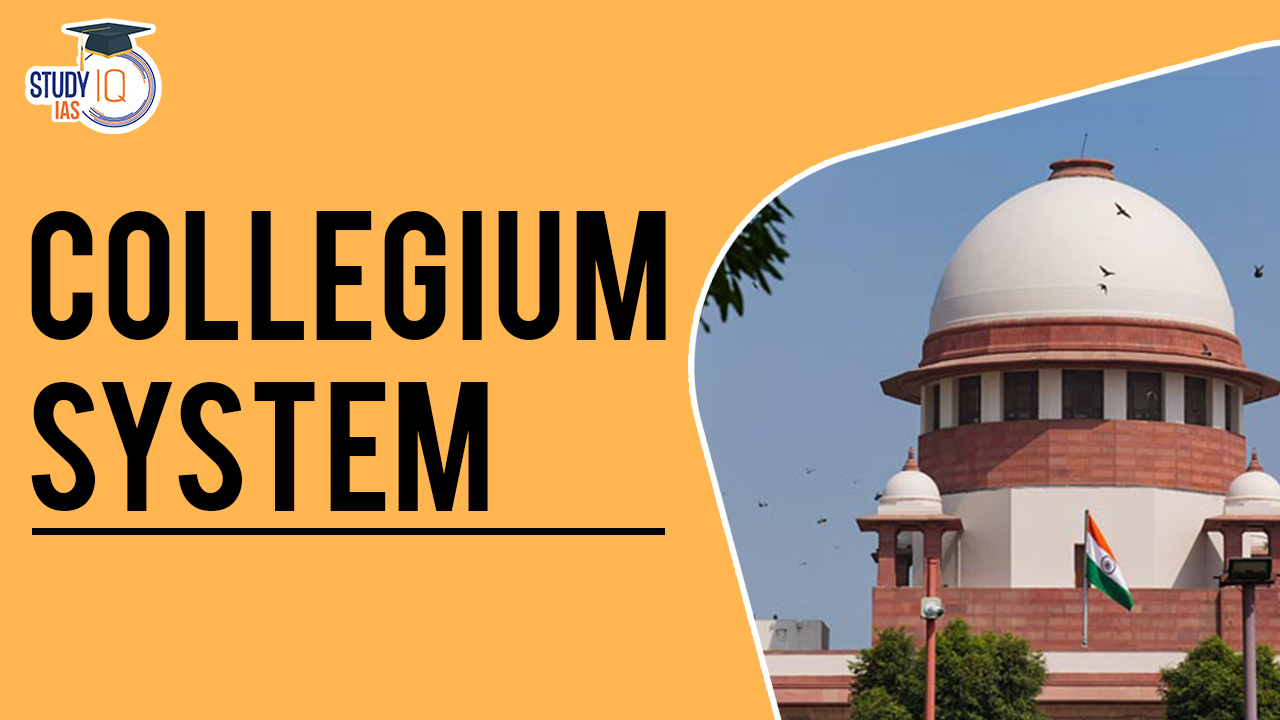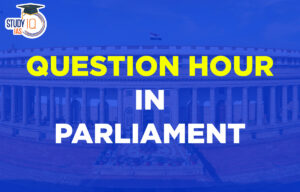Table of Contents
The Collegium System is a unique mechanism for appointing and transferring judges in India. It is a system where the Chief Justice of India (CJI) and the four senior judges of the Supreme Court decide on judicial appointments and transfers. The Collegium System is not mentioned in the Indian Constitution or any amendment; instead, it has evolved through landmark Supreme Court judgments known as the “Three Judges Cases.”
This system plays a significant role in maintaining judicial independence and has been a subject of debate due to concerns regarding transparency, accountability, and political interference. As UPSC aspirants prepare for the exam, understanding the Collegium System and its implications is crucial.
Meaning of the Collegium System
The Collegium System in India is a process through which judges of the Supreme Court and High Courts are appointed and transferred. The concept of “judges appointing judges” was established through Supreme Court judgments rather than through constitutional provisions or parliamentary legislation.
Composition of the Collegium
- Supreme Court Collegium: The Chief Justice of India and the four senior-most Supreme Court judges.
- High Court Collegium: The Chief Justice of the High Court and its four senior judges.
- The High Court Collegium recommends names to the Supreme Court Collegium, which then forwards the approved names to the Government of India.
- The government can return the names with objections, but if the Collegium reiterates them, the government must approve them.
Collegium System in India
The Supreme Court of India is known as one of the most powerful courts in the world. Since the 1990s, it has used the Collegium System to appoint judges, which has expanded its judicial review powers. The Collegium consists of the Chief Justice of India and four other senior judges who appoint judges to the High Court and Supreme Court, as well as manage their transfers.
The Collegium System was created to ensure that the judiciary remains independent from the Executive and Legislative branches, following the principle of Separation of Powers. This means that each branch has its own role and authority, which helps maintain judicial independence, as envisioned in the Indian Constitution.
However, India’s political and judicial history shows a constant struggle between the Executive and Judiciary, often influenced by politics, which can undermine justice. If the Collegium System operates without political interference, it could significantly strengthen the judicial process, as it is led by some of the most experienced judges.
Collegium System for Appointment of Judges
The Collegium System, which arose as a result of Supreme Court decisions rather than an Act of Parliament or a Constitutional provision, is the system for choosing judges.
| The government only gets involved once the collegium has decided on names. |
|
Following this system of judicial selection, the collegium will recommend names of candidates to the Central Government. The names of the nominees will also be forwarded by the national government for public discussion. Because there is no predetermined time limit, the appointment process takes a long time. The government must approve the names if the Collegium sends them again with the same name.
Collegium System Evolution
The Indian Constitution was approved on January 26, 1950, and by its provisions, the Chief Justice of India was chosen by the President of the nation, and the Supreme Court judges were chosen after consulting the CJI. The following stages make up the creation of the Collegium:
CJI’s Appointment (1950-73)
Both the nation’s administration and the CJI were in agreement with one another. A convention was established for the selection of the senior Supreme Court justice. As Justice AN Ray had replaced three more senior Supreme Court justices, the appointment of AN Ray as the CJI in 1973 broke this tradition. When a new CJI was appointed in 1977 after one of his seniors had been replaced, this infringement was once more noted. These offences led to a conflict between the country’s judicial and executive branches.
First Judge’s Case (1982)
The Supreme Court received a petition in 1982 that would later become known as the S.P. Gupta Case or First Judges case. The meaning and implications of the phrase “consultation” in article 124, which defines the appointment process, were two key topics covered during the case’s hearings. The Supreme Court rejected the theory that assumed “concurrence” was the meaning. The SC’s consultation was not required for the president to make his decision. The SC ruled that the High Court justices could be transferred from any state court to any other state court, even against their choice.
Second Judge’s Case (1993)
The Supreme Court Advocates on Record Association (SCARA) filed another appeal with the Supreme Court in 1993. The SC overturned the prior ruling and changed the definition of “consultation” to “concurrence,” making it mandatory for the President to contact the CJI before appointing judges. The Collegium System was created as a result of the earlier decision being reversed.
Third Judge’s Case (1998)
Articles 124, 217, and 22 of the Indian Constitution, which are references to the Supreme Court made by the President, sparked new debate over the definition of “consultation” in 1998. The Chief Justice of India will not be the only person involved in the consultation process; there will also be a collegium made up of four of the Supreme Court’s most senior judges. The Chief Justice of India cannot offer recommendations to the government if there is even a 2-judge disagreement. The Collegium System of India was created with the following provisions for the appointment of judges.
Collegium System
The Collegium would submit suggestions for the Central Government’s selection of judges. The Collegium may also receive candidates from the federal government for recommendation. Since there are no provisions defining a time limit for the appointment process, it takes a considerable amount of time. The Central Government will have to approach the Collegium if it sends the Collegium’s report back for further review but the latter makes no modifications to it.
Collegium System vs. National Judicial Appointment Commission
The Collegium System was intended to be replaced by the National Judicial Appointments Commission (NJAC). The following has been explored regarding their variations;
| National Judicial Appointment Commission (NJAC) | Collegium System |
| The NJAC is an organization that was suggested by the NJAC bill, and its provisions would have been by Article 124A of the Constitution. | Since the ‘Three-Judges Cases’ gave rise to the Collegium System and it evolved from them, it has been in existence. The Constitution doesn’t make reference to it. |
| The NJAC would have had the Executive’s participation in the selection of the judges. | The Collegium does not interfere in this way. It sought to maintain the separation of the Executive from the Judiciary in order to preserve the independence of the latter. |
The members would have been;
|
The members of the SC Collegium are;
The members of the HC Collegium are;
|
| People outside of the judiciary would have a voice in the judge’s appointment. | The Indian Judiciary’s top and most senior members made the choices, and those rulings had to be followed. The GoI can’t get involved. |
Collegium System Criticism
The Indian Constitution does not mention the Collegium system, it developed from court rulings and gives judges full control over appointments. There are no elections for judges, making the process undemocratic and lacking accountability to the public.
The selection process is not transparent or official, and there are no clear guidelines. Judge eligibility is not set, leading to concerns about nepotism, where relatives of former judges often get top positions. This system favours connections over merit.
The collegium has not been able to stop the rising number of cases and openings for judges. The Supreme Court’s decision in the Second Judge’s case (1993), which stated: that Seniority among Judges in their High Courts and on an all-India basis is important and should be taken into consideration while making these recommendations to the Supreme Court, is not consistent with the recent supersession in appointment.
Recent Developments in 2025
- Judicial Transparency Reforms: The Supreme Court has introduced measures to increase transparency by publishing key decisions and reasons behind appointments and transfers.
- Public Scrutiny Mechanism: A new advisory panel has been proposed to review judicial appointments before final approval.
- Government-Judiciary Collaboration: A structured dialogue mechanism between the government and judiciary has been initiated to streamline appointments and reduce conflicts.
Collegium System UPSC
The collegium will suggest candidates to the Central Government under this procedure of appointing judges. The names of the suggested candidates will also be sent by the national government for consultation. There is no set time restriction for the appointment process, thus it takes a long time. The government must approve the names if the Collegium sends them again with the same name. Students can read all the details related to UPSC by visiting the official website of StudyIQ UPSC Online Coaching.


 Question Hour in Parliament: Meaning, Ty...
Question Hour in Parliament: Meaning, Ty...
 List of Governor of States in India, Con...
List of Governor of States in India, Con...
 Maharashtra Bill to Curb Urban Naxalism,...
Maharashtra Bill to Curb Urban Naxalism,...





















